Antennariidae
Frogfishes
Theodore W. Pietsch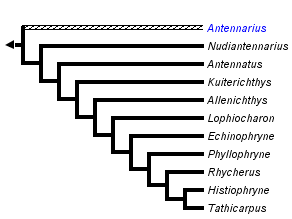


This tree diagram shows the relationships between several groups of organisms.
The root of the current tree connects the organisms featured in this tree to their containing group and the rest of the Tree of Life. The basal branching point in the tree represents the ancestor of the other groups in the tree. This ancestor diversified over time into several descendent subgroups, which are represented as internal nodes and terminal taxa to the right.

You can click on the root to travel down the Tree of Life all the way to the root of all Life, and you can click on the names of descendent subgroups to travel up the Tree of Life all the way to individual species.
For more information on ToL tree formatting, please see Interpreting the Tree or Classification. To learn more about phylogenetic trees, please visit our Phylogenetic Biology pages.
close boxIntroduction
Frogfishes of the family Antennariidae are typically small, globose anglerfishes easily distinguished from members of allied families by the presence of three well-developed dorsal spines, laterally directed eyes, a large, anterodorsally directed mouth, and a short, laterally compressed body (Pietsch, 1981). They share with other familes of the teleost order Lophiiformes a peculiar and unique mode of feeding that is characterized most strikingly by the structure of the first dorsal spine, which is placed out on the tip of the snout and modified to serve as a luring apparatus.
Frogfishes spend the greater part of their lives squatting on the bottom in shallow to moderately deep water, or as in the case of the single genus Histrio, clinging to floating sargassum. Despite their rather sedentary nature, all are voracious carnivores that wait patiently for smaller fishes or crustaceans to pass by, while they wriggle their bait to entice prey close to their cavernous mouths. Antennariids occur in all major tropical seas of the world except the Mediterranean. The family consists of 12 genera and 43 species.
Characteristics
Diagnosis
A lophiiform family unique and derived in having a greatly enlarged third dorsal spine (and associated pterygiophore), as well as a shortened body involving numerous associated specializations but reflected most strikingly by a sigmoid vertebral column (see Pietsch, 1981, figs. 12, 22-35, 41; 1984).
The familiy is further distinguished from all other families of the order by having the following combination of character states: body laterally compressed; mouth strongly oblique to vertical; eyes lateral; posteromedial process of vomer compressed, keel-like; distance between lateral ethmoids considerably less than that between lateral margins of sphenotics; postmaxillary process of premaxilla spatulate; ectopterygoid triradiate; palatine teeth present; dorsal head of quadrate narrow, narrower than ventral margin of metapterygoid; interhyal with a medial, posterolaterally directed process; basihyal present; branchiostegal rays 2 + 4 ; opercle reduced, the width equal to or less than 25% the length of suspensorium; pharyngobranchial I simple (absent in Lophiocharon and Histiophryne); spinous dorsal of 3 cephalic spines; illicial pterygiophore and pterygiophore of third dorsal spine with highly compressed, blade-like dorsal expansions; illicial bone not retractable within an illicial cavity; 3 pectoral radials; pectoral-fin lobe not membranously attached to rays of pelvic fin; pectoral fin single, the rays not membranously attached to side of body; pelvic fin of 1 spine and 5 rays. (Pietsch, 1981, 1984)
Description
Body short, globose, laterally compressed; mouth large, the upper and lower jaws with 2-4 more or less irregular rows of small, villiform teeth; opercular opening restricted to a small, elongate, tube-like opening immediately ventral to, or posterior to, base of pectoral fin (prolonged posteriorly, siturated halfway between base of pectoral lobe and anal fin, or reaching base of anal fin, in some species of Antennarius); spinous dorsal fin of 3 cephalic spines, the anteriormost spine (illicium) free and modified as a lure; distinct fleshy bait or esca usually present, but absent in Lophiocharon lithinostomus and Echinophryne; second and third dorsal spines usually more or less erect (laid back and bound down to surface of cranium by skin of head in Histiophryne), usually widely separated from each other and from soft-dorsal (connected to each other and to soft-drosal by skin in Lophiocharon and in some species of Antennarius); posterior end of pterygiophore of illicium usually cylindrical in cross section (dorsoventrally flattened and expanded laterally in Tathicarpus); pectoral lobe elongate, leg-like, usually broadly attached to side of body (free for most of its length in Histrio and Tathicarpus); skin usually coverd with close-set dermal spinules (spinules usually bifurcate, simple in Histiophryne, reduced, minute, or absent in Nudiantennarius and Histrio, absent in Phyllophryne and Rhycherus); cutaneous filaments or appendages nearly always present; mesopterygoid usually absent, present in Antennarius, Nudiantennarius, Antennatus, and Histrio; epural usually absent, present in Antennarius, Nudiantennarius, Antennatus, and Histrio; pseudobranch usually absent, present in Antennarius, Histrio, and Tathicarpus; swimbladder usually present, absent in Kuiterichthys and Tathicarpus.

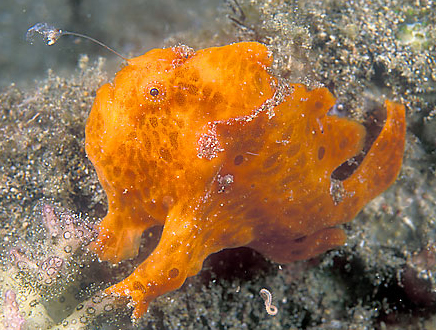
Antennarius pictus (Shaw & Nodder). © J. Ronsenfeld
Vomer and palatine well-toothed; pharyngobarnchial I, if present (absent in Lophiocharon and Histiophryne), usually toothless (a single tooth-bearing plate present on only right side of 73-mm specimen of Allenichthys examined osteologically); pharyngobranchials II and III well toothed; epibranchials usually toothless (a row of 6-11 teeth present on epibranchial I of Tathicarpus; a single tooth-bearing plate, or small remnants of a tooth-plate, present on epibranchial I of some specimens of Antennarius, Antennatus, Kuiterichthys, Allenichthys, Echinophryne, Phyllophryne, and Rhycherus); ceratobranchials I-IV usually toothless (a single tooth-plate, often reduced to a small remnant, present on ceratobranchial I of Allenichthys, some species of Echinophryne and Rhycherus); ceratobranchial V with 2-6 more or less irregular rows of teeth; hypobranchials II and III usually bifurcate proximally (hypobranchial II often reduced and simple in Kuiterichthys, Allenichthys, Echinophryne, Rhycherus, and Histiophryne); ossified basibranchial only rarely present; vertebrae 18-23, caudal centra 12-18, dorsal rays 10-16, anal rays 6-10, pectoral rays 6-14; usually only 7 innermost rays of caudal fin bifurcate (all rays bifurcate in Antennarius, Antennatus, Allenichthys, Lophiocharon, and Rhycherus; all simple in Tathicarpus).
Color and color pattern highly variable, with two extremes (the entire range of which can be assumed by living individuals of many species during a period of days or weeks, the specimens often changing radically upon preservation); a more common light-color phase with light-tan to yellow, orange, light-brown, or rust background often overlaid with black, brown, pink, or bright-yellow streaks, bars, and/or spots o the head, body, and fins; and a dark-color phase with green, dark-red, dark-brown, to black background with streaks, bars, and/or spots often (but not always) showing through as deeper black, tips of rays of paired fins often white.
Juveniles and adults benthic in 0-300 m, with the single exception of Histrio, which is pelagic in floating sargassum weed; adults of some species attaining a standard length of at least 35 cm; occurring in all major tropical seas of the world except the Mediterranean; 12 genera and 43 species.
Discussion of Phylogenetic Relationships
Pietsch and Groebecker (1987) unsuccessfully attempted to provide a cladistic analysis of the phylogenetic relationships of antennariid genera. In particular, monophyly for the 24 species of the genus Antennarius was not established. Despite considerable effort, they were unable to identify a single clearly derived feature shared by all included taxa. Thus, Pietsch and Grobecker (1987) defined the genus by a suite of what are believed to be primitive features.
Evidence indicates that Antennarius is the least derived member of the family (Pietsch, 1984). All of the known characters of systematic importance found among the 12 genera (at least all of those characters for which relative primitiveness of states could be reasonably hypothesized) appear to be present in Antennarius in the primitive state. Each of the remaining 11 genera possesses at least two, and in some cases as many as nine, apomorphic character states (autapomorhpic states included) that indicate its derived position relative to Antennarius.
Whereas a hypothesis of monophyly for each of the remaining 11 genera can be supported (six genera being monotypic and none containing more than three species), their phylogenetic relationships as elucidated by cladistics remain largely unknown, and they are here sequentially arranged solely on the basis of increasing relative specialization. No group of two or more genera possesses any convincing synapomorphy that does not also occur within lophiiform taxa lying outside the group in question.
Distribution
Frogfishes are widely distributed in tropical waters of all four major marine faunal realms of the world. By far the majority of the species, however, and all but three of the genera, are confined geographically to the Indo-Australian Archipelago. The family is well represented in the Gulfs of California and Mexico, the Red Sea, and the Persian Gulf, but like all antennarioids it is unknown from the Mediterranean Sea. With the possible exception of Histrio, Antennarius, with its 24 species, is the only circumglobal genus. In the Western Atlantic it ranges from Long Island, New York, to the southern-most coast of Brazil, and in the Eastern Atlantic, form the Azores and the coast of Senegal to South-West Africa. In the Indo-Pacific it ranges from the tip of South Africa and the Red Sea eastward to virtually all oceanic island groups of the South Pacific, and from southern Japan to New Zealand and the tropical waters of Australia. In the eastern Pacific Ocean, Antennarius occurs throughout the Gulf of California to northern-most Peru and the Galápagos Islands, with two records from Isla San Félix, off central Chile.
The genus Antennatus, embracing two species, occurs throughout the tropical Indo-Pacific and Easter Pacific oceans, from East Africa to the Gulf of California, and the coast of Mexico and Central and South America as far south as Colombia and the Galápagos Islands. The monotypic genus Histrio is sympatric with sargassum throughout the Atlantic and Indo-Pacific oceans, with confirmed captures made as far east as Guam in the north and Tonga in the south. Histiophryne occurs from Taiwan, the Philippines, and the Moluccas to the southern coast of Australia. Lophiocharon is found throughout the islands of the Philippines and Indonesia to the northern coast of Western Australia, Northern Territory, Gulf of Carpentaria, and the northeastern coast of Queensland. Tathicarpus is restricted to the southern coast of New Guinea and to Australia about as far south as Perth in the west and Brisbane in the east. Allenichthys occurs only along the shores of Western Australia below about 21° S latitude, with a single record from Port Lincoln, South Australian. Nudiantennarius is known from only four specimens collected off Luzon in the Philippines and at Ambon in the Moluccas, Indonesia. All four remaining genera of the family are restricted to the subtropical coastal waters of Australia and Tasmania below about 30° S latitude.
Key to the Known Genera
This key works by progressively eliminating the most derived taxon, and for that reason should always be entered from the beginning. All features listed for each species-group must correspond to the specimen being keyed; if not, proceed to the next set of characters. The figures accompanying the key are diagrammatic; dermal spinules and cutaneous appendages (with minor exceptions) are not shown.
References
Pietsch, T. W. 1981. The osteology and relationships of the anglerfish genus Tetrabrachium, with comments on lophiiform classification. U. S. Fish. Bull., 79(3): 387-419.
Pietsch, T. W. 1984. The genera of frogfishes (family Antennariidae). Copeia, 1984(1):27-44.
Pietsch, T. W., and D. B. Grobecker. 1987. Frogfishes of the World: Systematics, Zoogeography, and Behavioral Ecology. Stanford University Press, Stanford, xxii + 420 pp.
Title Illustrations

| Scientific Name | Species of the family Antennariidae |
|---|---|
| Specimen Condition | Live Specimen |
| Identified By | T. W. Pietsch |
| Image Use |
 This media file is licensed under the Creative Commons Attribution-NonCommercial License - Version 3.0. This media file is licensed under the Creative Commons Attribution-NonCommercial License - Version 3.0.
|
| Copyright |
© Theodore W. Pietsch

|
About This Page
Theodore W. Pietsch

University of Washington, Seattle, Washington, USA
Correspondence regarding this page should be directed to Theodore W. Pietsch at and Christopher P. Kenaley at
Page copyright © 2005 Theodore W. Pietsch
 Page: Tree of Life
Antennariidae. Frogfishes.
Authored by
Theodore W. Pietsch.
The TEXT of this page is licensed under the
Creative Commons Attribution-NonCommercial License - Version 3.0. Note that images and other media
featured on this page are each governed by their own license, and they may or may not be available
for reuse. Click on an image or a media link to access the media data window, which provides the
relevant licensing information. For the general terms and conditions of ToL material reuse and
redistribution, please see the Tree of Life Copyright
Policies.
Page: Tree of Life
Antennariidae. Frogfishes.
Authored by
Theodore W. Pietsch.
The TEXT of this page is licensed under the
Creative Commons Attribution-NonCommercial License - Version 3.0. Note that images and other media
featured on this page are each governed by their own license, and they may or may not be available
for reuse. Click on an image or a media link to access the media data window, which provides the
relevant licensing information. For the general terms and conditions of ToL material reuse and
redistribution, please see the Tree of Life Copyright
Policies.
- First online 01 November 2005
Citing this page:
Pietsch, Theodore W. 2005. Antennariidae. Frogfishes. Version 01 November 2005 (under construction). http://tolweb.org/Antennariidae/21993/2005.11.01 in The Tree of Life Web Project, http://tolweb.org/




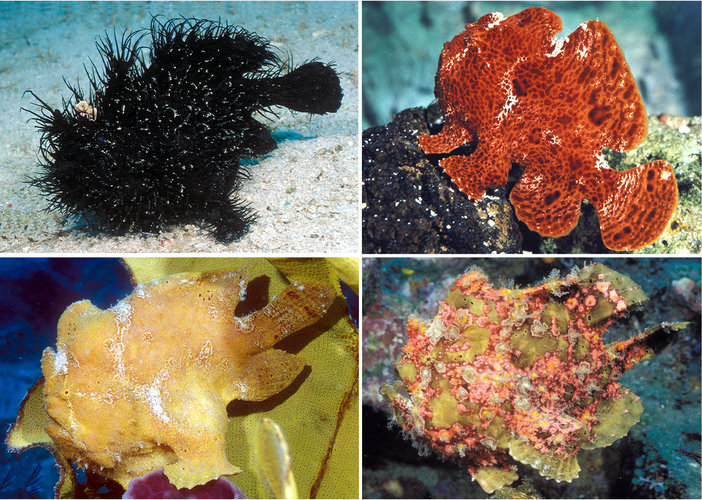
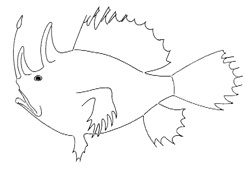
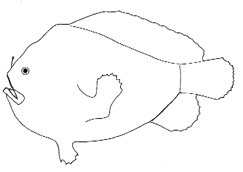
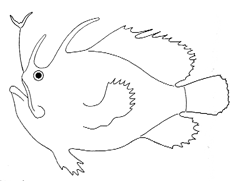
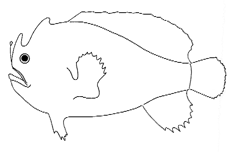
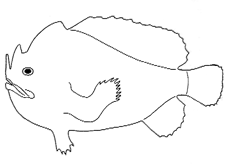
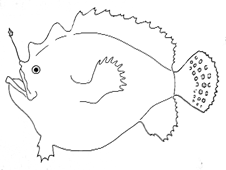
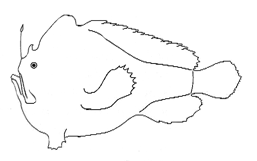
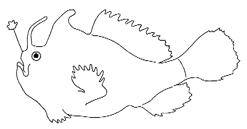
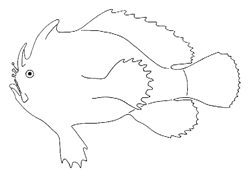

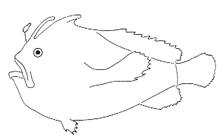
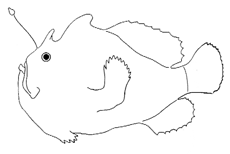


 Go to quick links
Go to quick search
Go to navigation for this section of the ToL site
Go to detailed links for the ToL site
Go to quick links
Go to quick search
Go to navigation for this section of the ToL site
Go to detailed links for the ToL site